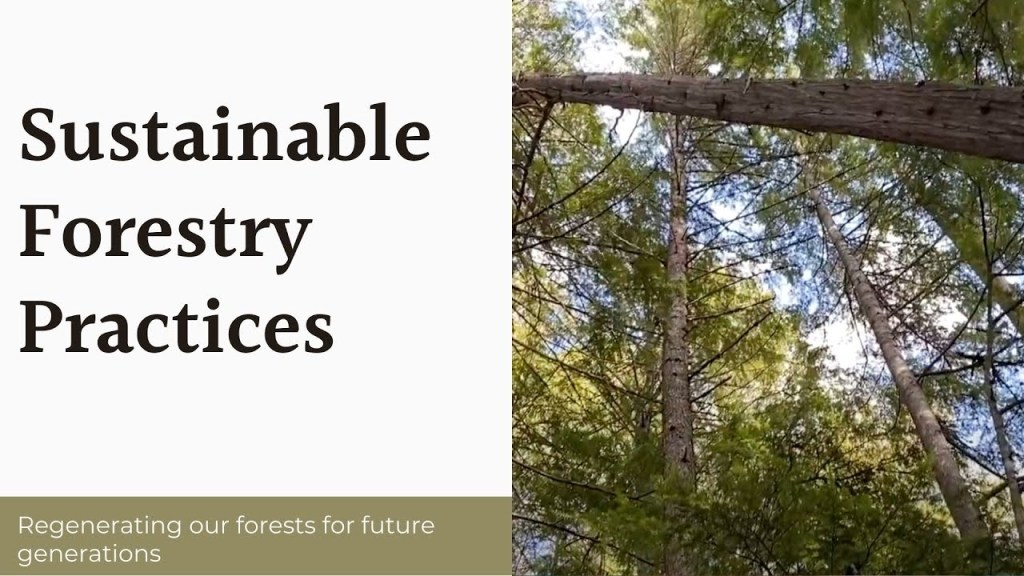Sustainable Forestry Practices: Preserving Nature for Generations to Come
In an era where environmental concerns are at the forefront, sustainable forestry practices have emerged as a crucial component of responsible land management. With forests playing a vital role in maintaining biodiversity, mitigating climate change, and providing resources for various industries, it is imperative that we adopt practices that ensure their long-term health and productivity.
1. Forest Management Plans
A key element of sustainable forestry is the implementation of comprehensive forest management plans. These plans outline strategies to balance economic objectives with ecological stewardship. They include provisions for tree planting, harvesting techniques, wildlife conservation, and monitoring programs.
Forest management plans are tailored to specific regions and take into account factors such as soil type, climate conditions, and species diversity. By adhering to these plans, foresters can maintain healthy ecosystems while also meeting societal demands for timber products.
2. Selective Harvesting Techniques
Gone are the days when clear-cutting was considered a standard practice in forestry. Today’s sustainable forestry methods prioritize selective harvesting techniques that mimic natural disturbances like wildfires or insect outbreaks.
Selective logging targets individual trees or small groups within a stand while leaving the majority of trees intact. This approach helps maintain the structural integrity of the forest canopy, preserves habitat diversity for wildlife species dependent on certain tree species or age classes, and minimizes soil erosion risks.
3. Reforestation Efforts
To ensure ongoing woodland regeneration after harvests or natural disturbances, reforestation efforts play a pivotal role in sustainable forestry practices. Successful reforestation involves careful planning regarding appropriate tree species selection based on site conditions and future climate projections.
Additionally, promoting natural regeneration through seed dispersal by wind or wildlife is encouraged whenever possible. Combining these approaches helps establish diverse forests resilient to future threats such as pests or diseases while ensuring continuous carbon sequestration capacity.
4. Protecting Biodiversity Hotspots
Forests serve as homes for countless plant and animal species, making biodiversity conservation a top priority in sustainable forestry practices. Maintaining intact habitats and protecting biodiversity hotspots are essential to preserve ecological balance.
To achieve this, sustainable forestry focuses on creating buffer zones around sensitive areas such as wetlands or old-growth forests. These protected zones act as refuges for rare or endangered species while allowing for sustainable timber harvesting in surrounding areas.
5. Responsible Forest Certification
Certification systems like the Forest Stewardship Council (FSC) play a critical role in promoting sustainable forestry practices worldwide. FSC certification ensures that forests are managed responsibly, considering economic, social, and environmental factors.
By adhering to strict standards set by these certifying bodies, forest owners and managers demonstrate their commitment to sustainability. Certified products carry labels indicating responsible sourcing, enabling consumers to make informed choices when purchasing wood-based products.
6. Community Involvement
Sustainable forestry goes beyond just environmental stewardship; it also involves engaging local communities in decision-making processes. Collaborative approaches empower stakeholders by incorporating their knowledge of the land’s history and ensuring their needs are considered alongside environmental concerns.
Engaging with indigenous peoples who have maintained deep connections with forests for generations is particularly vital. Their traditional knowledge can provide valuable insights into sustainable resource management techniques that have been passed down through generations.
7. Sustainable Wood Products
Promoting the use of sustainably sourced wood products is another crucial aspect of sustainable forestry practices. By choosing certified wood products or those made from recycled materials, consumers contribute directly to supporting responsible forest management initiatives.
Furthermore, encouraging innovation in product design can reduce waste generation and promote more efficient resource utilization throughout the supply chain. This includes utilizing wood residues for renewable energy production or developing new composite materials that require fewer raw resources.
In conclusion, sustainable forestry practices aim to strike a balance between meeting society’s demand for timber while preserving forest ecosystems’ health and vitality. Through comprehensive forest management plans, selective harvesting techniques, reforestation efforts, protection of biodiversity hotspots, responsible certification systems, community involvement, and sustainable wood product choices, we can ensure that future generations will continue to benefit from the many invaluable services provided by forests. Let us embrace these practices as responsible land stewards and guardians of our natural heritage.


Leave a comment